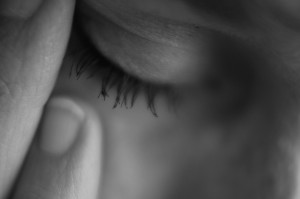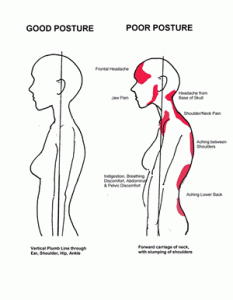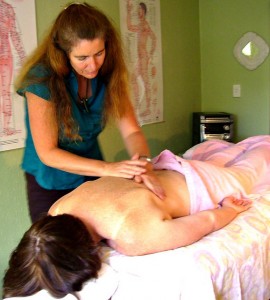There are many factors that contribute to headaches. One factor is the irritation or inflammation of nerves located in the neck that can actually refer pain into the face and scalp which can shoot up and cause a headache. This is what is referred to as a neck headache.
What is a ‘neck headache’?
A ‘neck headache’ (medically known as Cervicogenic headache) is a secondary headache disorder which is caused by a neck joint problem. The neck headache can be alleviated by fixing the neck problem.
Common causes
Common causes of neck problems that lead to neck headaches include:
- Whiplash: when the head is violently snapped backward and forward, commonly experienced in rear-end car collisions. The muscles and ligaments of the neck are strained and torn. In severe cases, the vertebrae of the neck can be dislocated or fractured.
- Trauma: caused by injuries sustained from, for example, falls or sporting accidents. The muscles, ligaments or bones can be affected.
- Inflammation or degeneration of the cervical spine: degeneration of the vertebrae, commonly caused by diseases such as osteoarthritis or spinal cord tumours
- Wear and tear: the ageing process can lead to a progressive degeneration of the neck vertebrae.
How posture plays a part in neck problems (and headaches)
Our posture can also play a role as the way we stand, sit and lie down can put unnecessary tension on the structures of the neck. Common problems of posture and poor habits include:
- slouching while sitting down
- spending too long sitting down, such as working at a computer
- sleeping on the stomach with the head always faced to one side
- clenching the jaw.
How to tell if it’s a neck headache
Commonly, neck headache sufferers will usually notice:
- tenderness at the top of the neck and base of the skull
- neck stiffness or a mild loss of movement
- the headache may seem to radiate from the back to the front of the head
- the headache be provoked or eased by a neck movement, a sustained posture, stomach sleeping with the head turned to one side
- the headache normally appears to be worse on one side of the head, the side is normally constant and does not swap sides
- the headache appears to temporarily ease up when apply pressure or a little massage on the neck or at the base of the skull.
How can Massage Therapy help?
Remedial massage techniques can have a very quick and effective result for relieving neck headaches:
- Stiff neck joints may need to be loosened with joint mobilization (gentle gliding techniques and joint traction)
- Hypermobile joints may require specific deep neck muscle strengthening exercises to stabilize, control and limit the joint movement available.
- Tight or overactive muscles may require stretching and massage (sometimes combined with acupuncture, dry needling, or other relaxation techniques).
- Weak muscles may require specific strengthening and postural exercises for shoulder and neck muscles.
- Posture correction may be recommended via specific exercises.
Massage treatments are performed on a regular basis to help the body maintain an optimal level of relaxation and stress-relief. This approach reduces the chances of headaches attacks significantly by relaxing muscle spasms and trigger points.
By focusing on the neck, shoulders, and head, massage can decrease the pain and discomfort brought on by headaches.
Benefits of relieving tension related headaches:
- Decreases occurrences of tension headaches, sleep disturbances and distress symptoms
- Allows one to maintain a level of relaxation and stress-relief, reducing the chances of stress induced migraines
- Massage for headaches can also reduce muscle spasms and trigger point tension: the neck muscles work optimally when they have normal resting tension, length, strength, power and endurance.
What results should you expect?
If the headache is solely caused by neck headache, it is common to experience instant relief.
Depending on the severity and what are the specific causes of it, most sufferers will resolve their neck headache within few treatments some others within few months. Anyhow it is really important for the rehabilitation to be conscious of the causes of the headaches and keep doing the specific exercises suggested from your Massage therapist that will help to avoid them in the future.
What are the symptoms and characteristics of neck headache?
Neck headaches can often be confused with migraine, since the head pain is typically felt in the same area as a migraine. One of the main differences between neck headache and migraine is that during the massage treatment of the neck muscles the headache will alter or relieve immediately.
What if the neck isn’t sore?
Even if the neck isn’t sore or painful, it’s possible to still experience neck headaches: the neck joints may not be sore in a rest position, but they may be tender to touch or painful on movement. If the headache or migraine has been present for years and your neck has not been examined, then a thorough neck examination is recommended and is appropriate to either confirm and treat the neck headache or exclude a neck disorder as the cause of your headache. It’s recommend to have at least cervical spine X-rays if you have been suffering headaches or head pain for any extended period.
If you’ve had ongoing headache problems, neck pain and other correlated symptoms book an appointment with our Remedial Massage Therapist Elisa Spagni to discuss a massage treatment plan.




